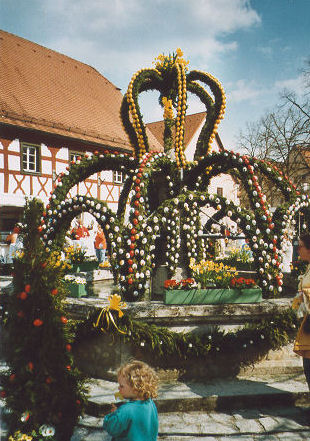|
Egloffstein
Egloffstein is a municipality in the district of Forchheim in Bavaria in Germany. Geography Location The village of Egloffstein is a state-recognised climatic spa and lies in the valley of the Trubach river on the hillside beneath the eponymous castle. Neighbouring communities Its neighbouring communities (clockwise from the north) are: Gößweinstein, Obertrubach, Gräfenberg, Leutenbach, Pretzfeld Administrative subdivisions Egloffstein is divided into 16 parishes: * Affalterthal above Egloffstein in the upper part of the Mostvieler valley. * Bieberbach is well known for its great '' Osterbrunnen''. In 2005, however, it had to concede its title as the "Greatest Osterbrunnen in the World" to Sulzbach-Rosenberg. The village is first recorded in 1225. * Hundshaupten is known for its wildlife enclosure and petting zoo, and for the castle of Hundshaupten. Attractions Above the village stands the former mediaeval Egloffstein Castle of the lords of Egloffstein ... [...More Info...] [...Related Items...] OR: [Wikipedia] [Google] [Baidu] |
Egloffstein Castle
Egloffstein Castle (german: Burg Egloffstein) is a former high mediaeval, aristocratic castle, that stands immediately west of the eponymous village of Egloffstein in the Upper Franconian county of Forchheim in the German state of Bavaria. The castle may be visited for an entrance fee. Location The spur castle is located within the Franconian Switzerland-Veldenstein Forest Nature Park at a height of 443 metres on a rocky, eastwards-pointing promontory of the Rabenstein, about 80 metres above the village in the Trubach valley in the hill region of Franconian Switzerland. In the vicinity are also the castles of Thuisbrunn, Hundshaupten and Wolfsberg. Other castles not far from Egloffstein include the Altes Schloss on the Altschlossberg hill near Affalterthal, the ruins of Dietrichstein near Lützelsdorf and the ruins on the Zaunsbacher Berg and Thüngfelderstein as well as the former castle by Heidhof on the Schlossberg. History The earliest record of the lords of Egl ... [...More Info...] [...Related Items...] OR: [Wikipedia] [Google] [Baidu] |
Osterbrunnen
The Osterbrunnen (Easter Well or Easter Fountain) is a German tradition of decorating public wells or fountains with Easter eggs for Easter. It began in the early 20th century in the Franconian Switzerland region of Upper Franconia but has spread to other regions. The decoration is usually kept from Good Friday until two weeks after Easter. History Decorating a well for Easter honours water, essential for life, and Easter, the feast of renewed life. In addition to eggs (now often artificial, to guard against vandalism), paper ribbons called "Pensala" and garlands of evergreens are woven around well-heads or formed into crowns over them. In several locations flowers are also used. Franconian Switzerland (german: Fränkische Schweiz), so called for its rugged rock outcroppings, lies in the region of Upper Franconia in northern Bavaria. The tradition of Osterbrunnen began there in the early 20th century. The Osterbrunnen in Aufseß is said to have been first decorated around 190 ... [...More Info...] [...Related Items...] OR: [Wikipedia] [Google] [Baidu] |
Forchheim (district)
Forchheim is a ''Landkreis'' (district) in Bavaria, Germany. It is bounded by (from the north and clockwise) the districts of Bamberg, Bayreuth, Nürnberger Land and Erlangen-Höchstadt. History Until 1803 the region was divided between the clerical state of Bamberg and the margravate of Brandenburg-Kulmbach centred in Bayreuth. Then it fell to Bavaria. The district in its present borders was established in 1972 by merging the former district of Forchheim with parts of the dissolved districts of Ebermannstadt and Pegnitz. The city of Forchheim lost its status as a district-free city and became the capital. Geography The main river is the Regnitz, which runs from south to north through the western parts of the district. East of the river the land rises to the hills of the Frankish Alb. Coat of arms The coat of arms displays: * the lion of the clerical state of Bamberg Bamberg (, , ; East Franconian: ''Bambärch'') is a town in Upper Franconia, Germany, on the river Regnitz clo ... [...More Info...] [...Related Items...] OR: [Wikipedia] [Google] [Baidu] |
Gräfenberg, Bavaria
Gräfenberg is a Franconian town in the district of Forchheim, in Bavaria, Germany. It is situated 16km southeast of Forchheim and 25km northeast of Nuremberg. Location Gräfenberg is located in the southern part of Little Switzerland. The town is characterised by a great range of elevation (from 400 to 550 metres). A brook, the Kalkach, flows through the town with a steep drop. Gräfenberg is divided into 16 districts: *The town Gräfenberg *Lilling *Hohenschwärz *Kasberg *Walkersbrunn *Dörnhof *Thuisbrunn *Höfles *Sollenberg *Rangen *Haidhof *Schlichenreuth *Guttenburg *Neusles *Lillinger Höhe *Gräfenberger Hüll Pictures Image:Stadtkirche-Rathaus-Gräfenberg-16-05-2005.jpeg, Town church and town hall image:Kriegerdenkmal-Gräfenberg-16-05-2005.jpeg, Memorial for the fallen of World War I and II above the town. Image:Gräfenberg Panorama 01.jpg, A panorama of the center and eastern part of Gräfenberg. Religion Gräfenberg is a majority Protestant town; even so, some ... [...More Info...] [...Related Items...] OR: [Wikipedia] [Google] [Baidu] |
Ortsteil
A village is a clustered human settlement or Residential community, community, larger than a hamlet (place), hamlet but smaller than a town (although the word is often used to describe both hamlets and smaller towns), with a population typically ranging from a few hundred to a few thousand. Though villages are often located in rural areas, the term urban village is also applied to certain urban neighborhoods. Villages are normally permanent, with fixed dwellings; however, transient villages can occur. Further, the dwellings of a village are fairly close to one another, not scattered broadly over the landscape, as a dispersed settlement. In the past, villages were a usual form of community for societies that practice subsistence agriculture, and also for some non-agricultural societies. In Great Britain, a hamlet earned the right to be called a village when it built a Church (building), church. [...More Info...] [...Related Items...] OR: [Wikipedia] [Google] [Baidu] |

